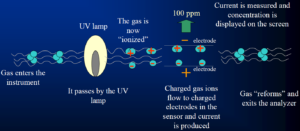A PID uses an ultraviolet light source (various wavelength to various applications – (9.6 eV, 10.6 eV and 11.7 eV) to break down chemicals to positive and negative ions (Ionization) that can very sensitively be measured with a detector. It measures the charge of the ionized ions and converts the signal into electric current in pico-ampers. The current is then amplified and software recalculated into “ppb – ppm or microgram/m3 – to miligram/m3 (depending to the molecular weight of the molecules)” units.
Due to the innovative design of the analytical PID chamber, the unique ECOPROBE 5 PID section measures the concentration in high dynamic range down from low levels (10 ppb) to relatively high levels of (4 000 ppm) of Volatile Organic Compounds (VOCs) and other toxic gases. Many hazardous material incidents are VOCs and the sensitivity of PID’s to VOCs make them an invaluable tool for initial incident assessment, leak detection and spill delineation. Proper selection of easily exchangeable PID lamp (together with easy software switch of their factory calibration) makes the system semi-selective and is an easy task to be set-up for various environmental projects/tasks.
After measurement, the ions reform the original gas. PIDs analysis are non-destructive, they do not permanently alter the gas, and allow the gas to be used for further analysis by another methods, in our case by IR absorption spectrometry. This enable the ECOPROBE system to be comfortably and in proven way used for head-space analyses of contaminated samples of the underground water.
In combination to the the advantage of cheap and reliable mapping the the contaminant spread in the soil subsurface areas, and the head-space analyses of the sampled underground water sample, the system provides extremely effective and fast in-situ system for evaluating and mapping the spread of the poisonous contaminants in the subsurface soil and underground water environment.


